A homemade hot sauce recipe made with garden grown aji peppers that have been fermented for 6 weeks, then processed with fresh garlic, lime juice and vinegar. Simple and delicious.
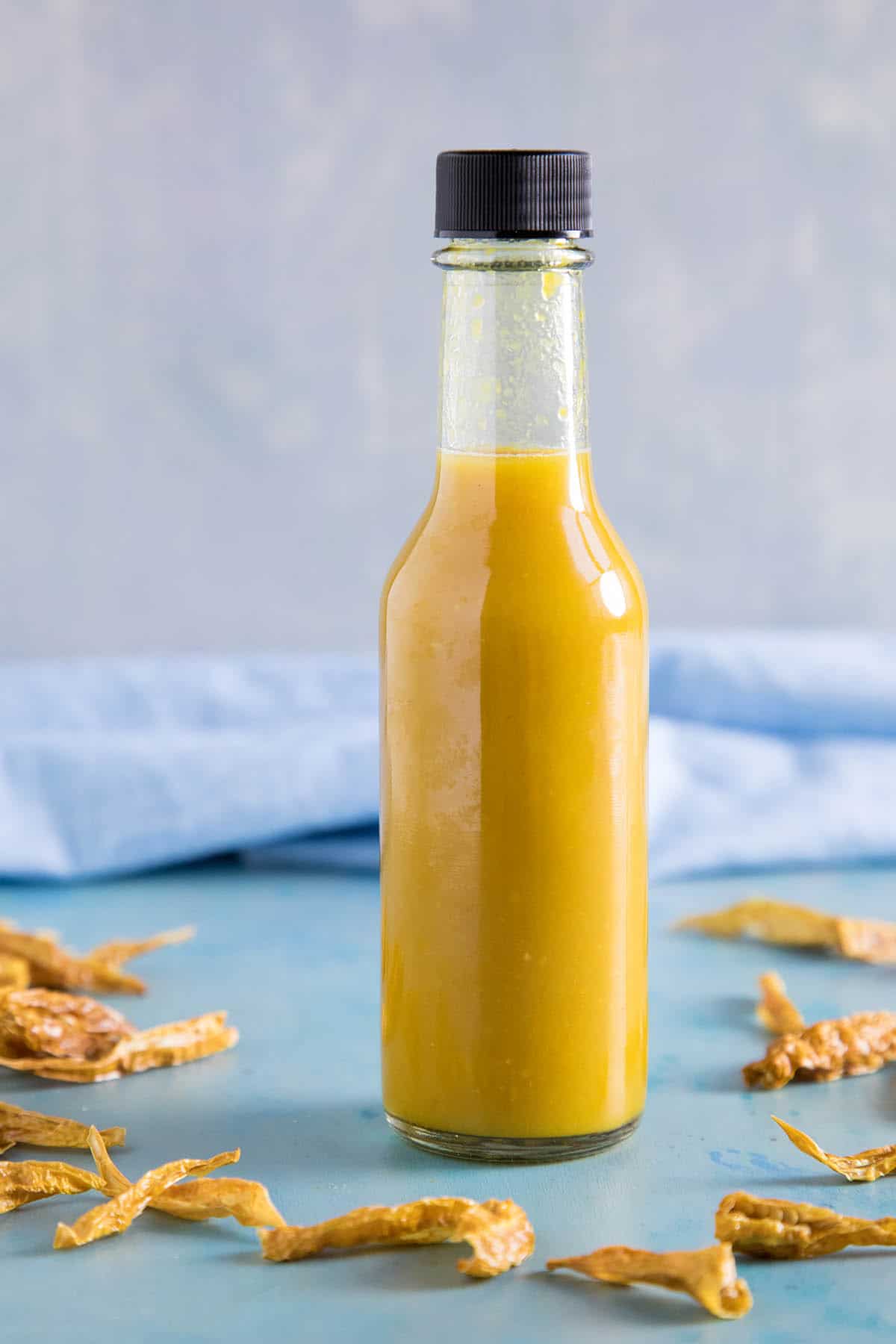
Fermented Aji-Garlic Hot Sauce Recipe
My fermentation experimentation continues. I grew several aji pepper varieties this year in the garden and you know, if you've ever grown aji peppers, that they are VERY productive.
It's one of the reasons I typically grow at least one aji variety each year, because of the large yield.
You'll find a good range of them as well, from sweets to hots, with flavor differences in between, so you're free to grow to your own taste preferences. The thing is, since they are SO productive, what can you do with all of those peppers?
You can cook them into meals, of course, freeze them, dry them to make homemade chili flakes and powders, but don't forget one important way to keep them...
HOMEMADE HOT SAUCE!
YES!
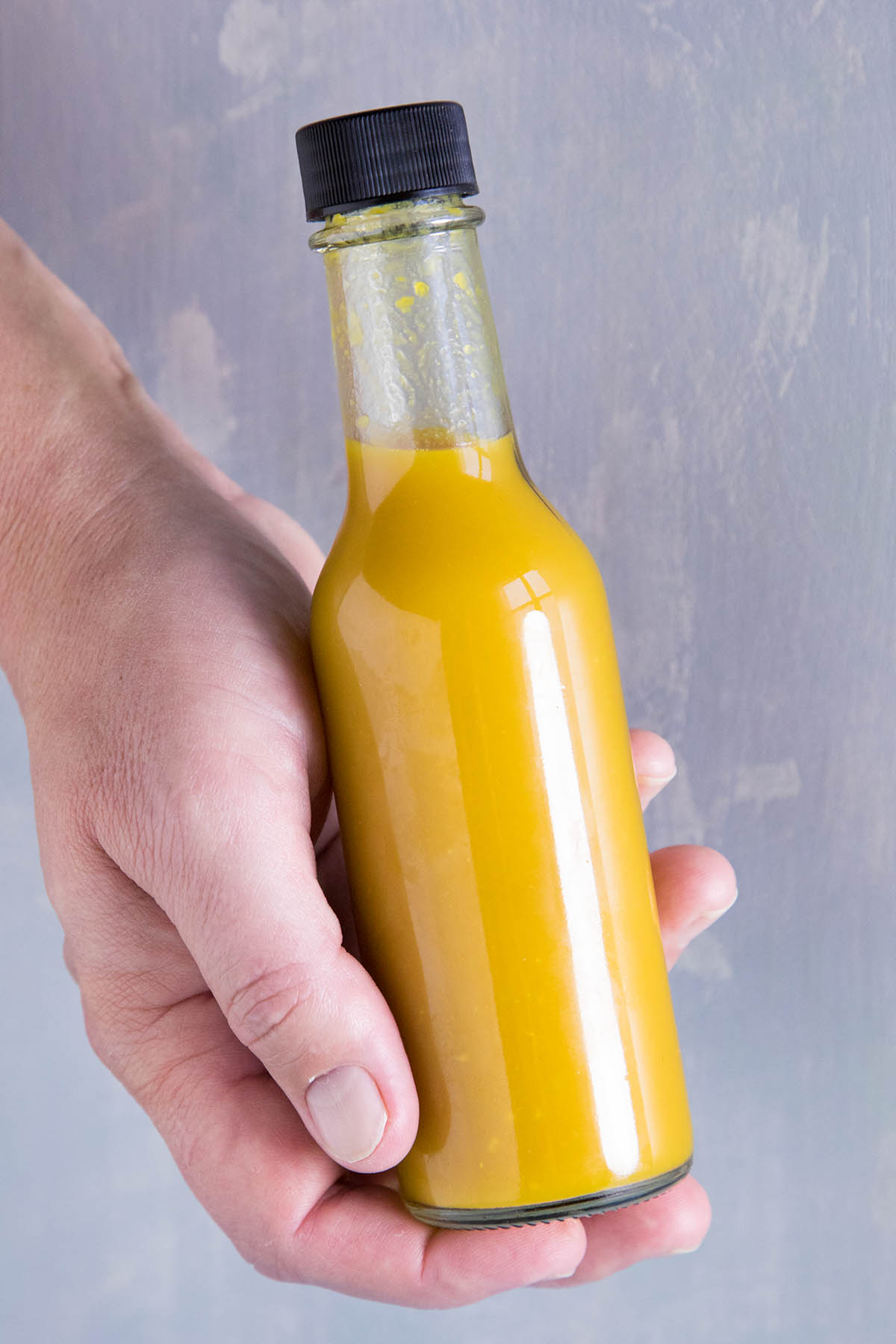
Fermented Aji-Garlic Hot Sauce Ingredients
- Aji Peppers. Fermented – I used Aji Habanero peppers (Learn How to Ferment Chili Peppers Here).
- Fresh Garlic Cloves. Chopped.
- Lime Juice.
- White Wine Vinegar.
How to Make This Fermented Aji-Garlic Hot Sauce - The Recipe Method
I took a solid pound of ajis - Aji Habaneros, in this case - and fermented them for 6 weeks. Learn How to Ferment Chili Peppers Here.
I used the brine method, which is my preferred fermenting method with chili peppers. Basically, I processed the peppers, added them to a jar, and poured a salt solution over them to cover. Leave a good inch of head space.
The brine is made by mixing 3 tablespoons of sea salt with 1 quart of unchlorinated water, which creates the ideal environment for good bacteria to do its work.
The process of fermentation basically breaks down the peppers, mellowing them out a bit, developing flavor. You can typically see that activity in the form of bubbles in the brine, though sometimes you'll have a quiet fermentation and won't see the bubbles.
As the process slows, activity tends to stop after a week or 2, though you can continue fermenting. In this case, I left mine in the pantry for 6 weeks before moving onward.
This is a very simple recipe once your fermentation is completed. I was looking for a no-nonsense hot sauce to keep in the fridge for splashing over foods, something vinegary, something garlicky, something a bit spicy.
This is a great one for that. Just cook the fermented peppers, including the brine, with lime juice, fresh garlic and vinegar, then process it in a food processor.
I strain mine afterward to give it a consistency more like Tabasco sauce, though you can keep it more chunky and solid if you'd like. If you DO strain it, try dehydrating those solids for a bit of homemade seasoning powder. There is plenty of life left in that pulp!
See How to Make Seasonings from Strained Hot Sauce Pulp.
Let me know how it turns out for you! Happy hot sauce making!
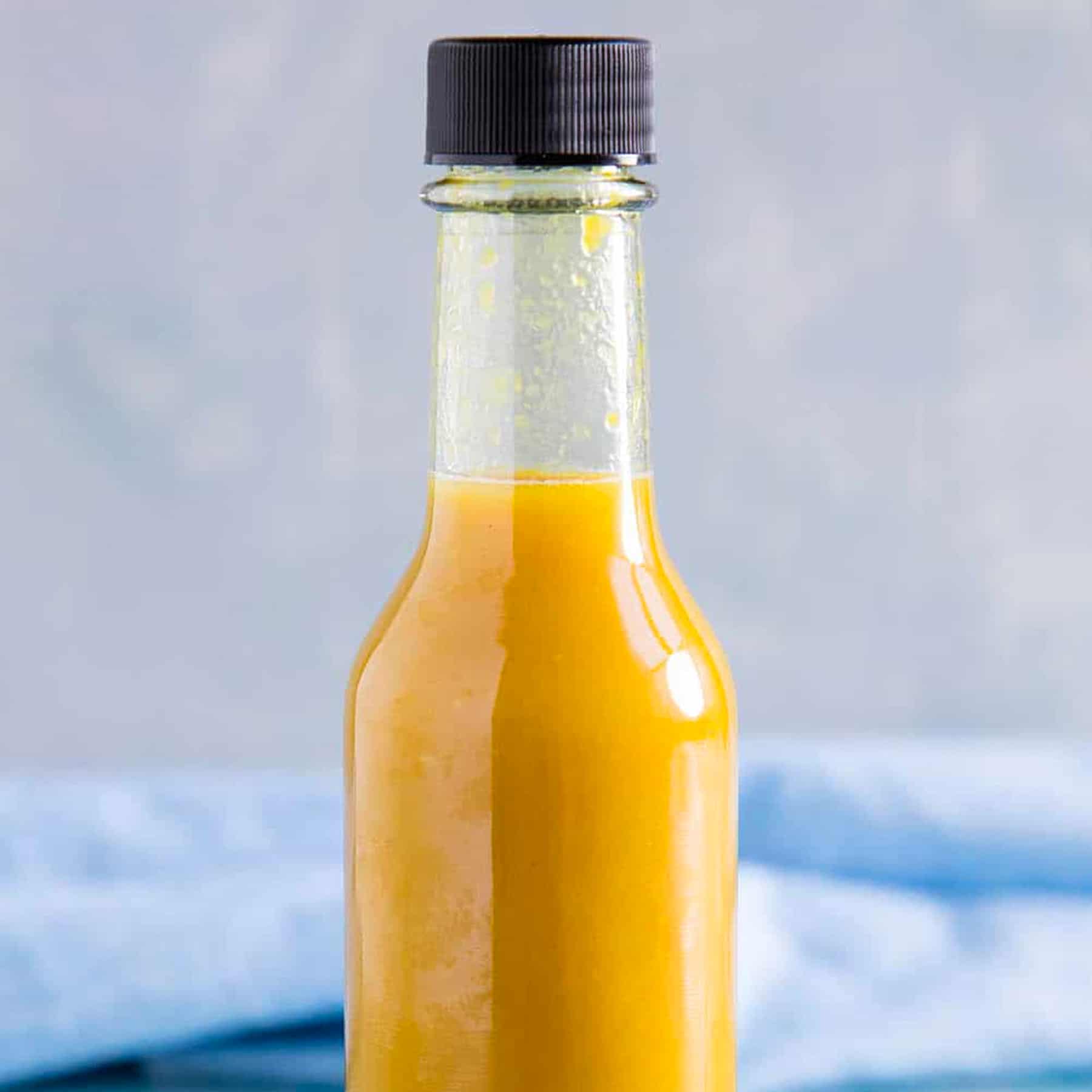
About the Fermenting Process
Most of the work is in the fermenting process, and that isn't much work. It's mostly chopping, measuring, and WAITING. Waiting is the hardest part.
You can ferment for a week or 2 to let the good bacteria do their work, but you can easily go longer. I often go about 8 weeks for mine.
If you're new to fermenting, I have some information you can refer to. See: How to Ferment Chili Peppers (How to Make Fermented Pepper Mash).
A few notes on making hot sauce.
Can You Make This Hot Sauce with Fresh Instead of Fermented Peppers?
Absolutely. Just skip the fermenting steps. You will still get a hot sauce with great flavor.
Fermented peppers offer up a milder flavor for your hot sauce blends, so the resulting hot sauce is typically more complex and nuanced than many other hot sauces. The choice is yours.
Adjusting the Hot Sauce Heat Factor
These aji peppers have a good level of heat to them, but if you're looking for an even HOTTER hot sauce, either add in a few heat level peppers that you'd like to cook with, such as habanero peppers or ghost peppers, or just use those exclusively for a different but delicious sauce.
Recipe Tips & Notes
- If you like the bottles that I am using, I find them locally sometimes, but I also order them through Amazon. Here is a link to some bottles I like (affiliate link, my friends!): Swing Top Glass Bottles, 8.5 Ounce - Set of 4. If you like the smaller bottles that most hot sauce makers use, here's another link: Hot Sauce Bottles, 5 Oz - 24 Pack.
- For longer storage you can process this hot sauce. Just be sure to use proper canning/jarring safety procedures.
- Aside from drizzling this sauce over anything you please, here's a post I did about How to Cook with Hot Sauce. As if you need even MORE reasons to eat hot sauce. I hope you find it helpful!
Storage & Leftovers
It should keep a few months easily in the fridge, or even longer. It's all about the acidity.
To be technical, target level ph for shelf stable foods is below 4.6 ph, but should probably be lower for home cooks, around 4.0 or so, to account for errors. If you're concerned, add more vinegar to lower the ph. Sauces made with fermented chili peppers will last even longer.
Check out These Related Recipes:
- Homemade Tabasco Sauce
- Caribbean Style Mango-Habanero Hot Sauce
- Pineapple-Mango Ghost Pepper Hot Sauce
- Homemade Caribbean-Style Sweet Chili Sauce
- Sweet Pepper Chili Sauce
- Hawaiian Chili Pepper Water
- Easy Aji Chili Sauce
- What is Xanthan Gum?
Check out more Hot Sauce Recipes or learn more about How to Make Hot Sauce. Also - Learn How to Ferment Chili Peppers Here.
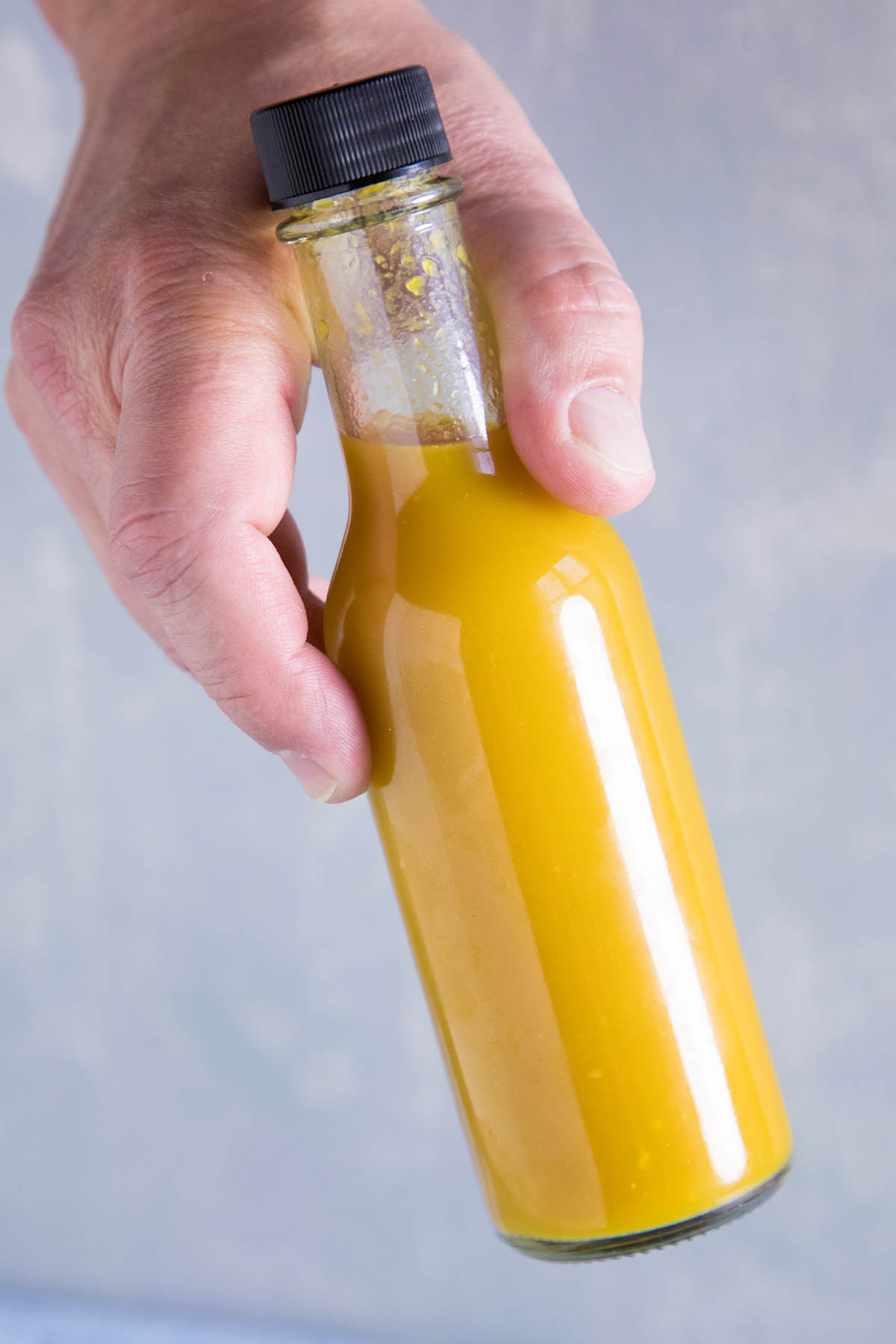
Got any questions? Ask away! I’m happy to help. If you enjoy this recipe, I hope you’ll leave a comment with some STARS. Also, please share it on social media. Don’t forget to tag us at #ChiliPepperMadness. I’ll be sure to share! Thanks! — Mike H.
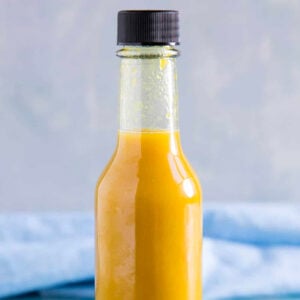
Fermented Aji-Garlic Hot Sauce Recipe
Ingredients
- 1 pound aji peppers fermented – I used Aji Habanero peppers (Learn How to Ferment Chili Peppers Here)
- 2 cloves fresh garlic chopped
- Juice from 1 lime
- 1/3 cup white wine vinegar
Instructions
- Add all the ingredients to a small pot and bring to a quick boil. Reduce the heat and simmer for 10 minutes.
- Cool a bit, then process it all in a food processor blender.
- Strain the sauce through a fine mesh sieve and bottle it up. You can discard the pulp or use it for soups or stews, or dehydrate it for seasoning.
Notes
Nutrition Information
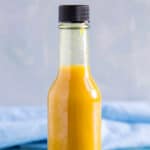


M says
Does this require refrigeration?
Mike Hultquist says
Not really, M, but I have a post on this subject here - Does Hot Sauce Need to be Refrigerated? https://www.chilipeppermadness.com/frequently-asked-questions/refrigerating-hot-sauce/
M says
Thank you!
Brian says
Gave this one a try Mike. I started off with a basic mash but it didn't develop enough brine to cover the peppers so I added a bit of brine pepper mash salt+water solution until the peppers were covered.
After about 6 weeks I cooked the peppers, garlic, white wine vinegar and juice of one lime per the recipe.
I chose to blend it all in a blender for a thicker sauce. And boy is it thick. I ended up adding about another 1/3 cup of white wine vinegar and the juice of another lime to try to thin it out some more but it's still kind of thick. Might be difficult to pour out of a bottle thick. Should I just keep adding more vinegar and lime juice until it's thin enough to pour at least?
Is there a more recommended way to thin. Some other kind of liquid perhaps?
Mike Hultquist says
Hey, Brian. Yes, you can add more vinegar to thin, but you can also use citrus. You CAN thin with water if you'd like, but check the acidity if needed for longer keeping. 4.6 is considered shelf stable. I always shoot for a bit lower. Let me know if this helps.
Brian says
Thanks for the response and input Mike.
I actually used a mild simple-syrup (sugar and water, but much less sugar than the typical 50%) to thin it down. It worked well and also added a nice tiny bit of sweetness.
I do need to get a ph meter though.
The heat level is nice from those lemon-drop peppers. Hotter than most commercially produced hot sauces (without getting into the niche super-hot ones). Hotter than I think most people that like "commercial" hot sauces can handle, but at a good heat level for hot sauce aficionados.
Mike Hultquist says
Excellent! Glad to hear it!
Chris Brown says
Hi Mike,
Is it ok to mix fermented chili peppers with fresh chili peppers to make one batch of hot sauce? Not sure if I should make separate batch with fresh pepper and another separate batch with fermented peppers or OK to mix them together to make one happy batch. Thanks so much.
Mike Hultquist says
Hi, Chris. Absolutely, you can mix them together to make a sauce. No problem at all. I hope you enjoy it!
BobB says
Mike-
This recipe may have just solved a mystery. My wife's favorite recipe for hot sauce here in Costa Rica (made here) is "Iguana Salsa - Picante Habenero" ...it's a step above their Jalapeno hot sauce. I have never been able to reproduce this (until now.)
Here in Costa Rica peppers called habaneros (on the plant) are most often Aji Habaneros. Which is what you prefer for your salsa in this recipe.
I think Iguana stole your recipe (lol.)
This recipe is equal ...or better than the Costa Rican Iguana Salsa Picante Habenero Sauce.
I did add a little salt which made it a little better ...and a little palm sugar (maybe not the best move ...honey posssibly a better choice.) But still 5 stars and thanks!
BobB
Mike Hultquist says
Glad you enjoyed it, Bob! Great to hear!
BobB says
We really do enjoy it. And we puree it as much as possible ...but do not strain/filter it. As such, nice recipe!
My lips have a tasty and comfortable burn at this moment from this sauce.
Thanks again!
BobB
Abbey says
We made this sauce with Carolina reapers and scorpions. It's great!!! Love the fermented hot sauce recipes!
Side note, I had questions about the fermentation process so emailed Mike. He was quick to reply with great answers!!!
Mike Hultquist says
Thanks so much, Abbey! Glad you're enjoying them!
Ward A Moroz says
I buy swing-top 8.5 oz glass bottles from Dollarama for $1.50 CAD. I imagine there are American equivalents to Canadian Dollaramas.
Mike Hultquist says
Perfect for hot sauces! Yep, we have "The Dollar Store" and a few others.
David Howell says
I made this today. Great recipe. I used honey fermented garlic instead of fresh and added 1/2 a reaper at the blend for a little extra heat. I’ll definitely be trying more of your recipes. Thanks!
Mike H. says
Sounds like a plan. Thank you, David!